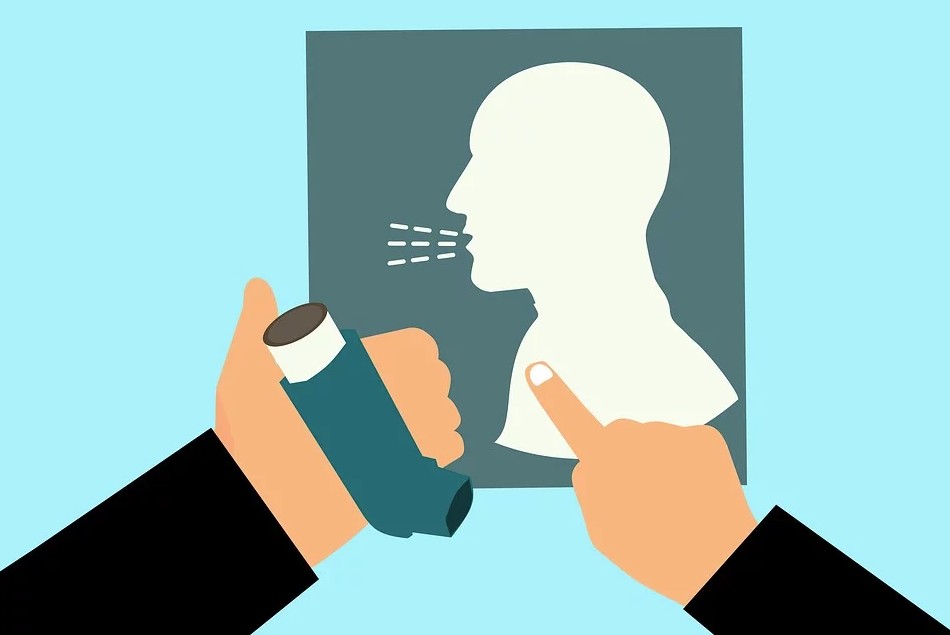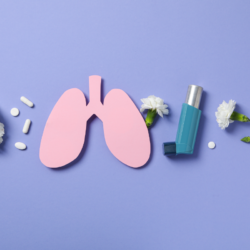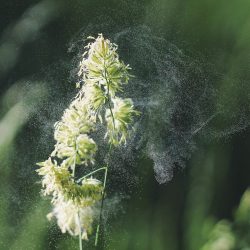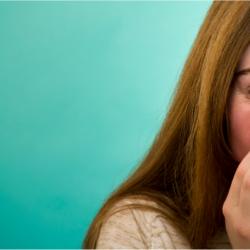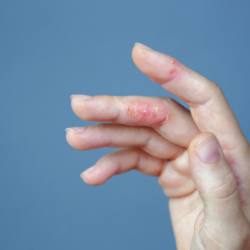Asthma is a chronic inflammatory disease of the bronchi with bronchoconstriction. This pathology is multifactorial, so in half of the cases of allergic origin. The bronchi of the allergic patientoverreact to certain stimuli (cold and dry air, allergens, pollutants, etc.). This bronchial hyperreactivity (involving mast cells, eosinophils and lymphocytes) in short results in inflammation. This inflammatory phenomenon then leads to edema; bronchial smooth muscle contraction (bronchospasm) and bronchial hypersecretion. The size of the bronchi narrows, exhalation is difficult (wheezing dyspnea) and can sometimes be life-threatening.
This acute syndrome, however, causes long-term deterioration of respiratory function.
Causes / Etiology
Asthma results from the conjunction of two kinds of factors:
-
Predisposing factors, congenital, which constitute the “ground”;
-
And immune-allergic, psychological or environmental promoting factors;
HOUSE
House dust is therefore often responsible for the majority of asthma cases. 75% of allergic asthma in children is due to allergy to house dust which includes a mixture of substances of animal and plant origin: dust mites, pet hair, plant fibers, skin scales, molds, ash, etc.
Thus, overexposure to household dust (stay in an old country house, vacation in a hotel or a rental house with dusty and dilapidated bedding, moves, games in an attic, days of major cleaning and sweeping, etc.) often triggers severe seizures.
ANIMALS
The dander of dogs and cats, human dander constitute important allergenic fractions of house dust which also contains bacterial allergens, molds, plant debris and microscopic algae. All of these allergenic fractions are present in commercial house dust extracts in varying concentrations and are used for diagnosis and desensitization.
Animals are frequently involved in sensitizing asthmatics, especially cats, whose hair and saliva are very allergenic. Hamsters, guinea pigs, rabbits, guinea pigs, mice, rats, horses and dogs also have allergenic integuments (hairs). It should be noted that animal hair gets inside the house because of the wind, even if the animal lives outside.
Hymenoptera venoms (bees, wasps, hornets) notably play a significant role.
The feathers present in pillows and eiderdowns are also allergenic. It is undoubtedly their high content of mites which is responsible for this reputation.
MUSHROOMS
A certain number of molds in the atmosphere nevertheless come from fungi present inside houses, especially at the level of ventilation and air conditioning ducts (central heating, air conditioning), and around water pipes (bathrooms , WC, kitchen). Household fungi also grow on frequently watered green plants, plant waste, animals, tapestries, wall paints and dyes, mattress dust and stuffed animals.
FOOD
Molds and yeasts are generally used in the food industry to prepare beer, wine, liqueurs, vinegar, sauerkraut, chocolate, cheeses such as Camembert and Bleu d’Auvergne.
The exact allergenic role of these molds and nutritional yeasts is not well known, but it seems that wine, cheese, wholemeal bread and pizza dough are responsible for asthma and rhinitis more frequently than one might think.
It is very difficult to prove a food allergy, but food or drink can be responsible for asthma (food allergens). The use of exclusion diets followed by reintroductions or challenge treatment with sodium cromoglycate given by mouth help in the diagnosis.
- Cow’s milk: lactoglobulins, serum albumin and lactalbumin are the allergenic proteins most frequently found in children
- The egg is an allergenic food
- Fish is a food rich in histidine and it is difficult to separate the allergy from a toxic type reaction by non-specific histamine reaction
- Cereals, crustaceans, molluscs, celery, raw carrots, potatoes, tomatoes, legumes, peanuts are sometimes incriminated
- Mustard, coffee, herbs, chocolate can cause asthma attacks by sudden histamine release
- Synthetic dyes including tartrazine (E102), natural dyes, mineral dyes, preservatives: benzoic acid and derivatives, nitrites and diphenyls may be involved
Various contaminants in food can play a role: pesticides, insecticides, antibiotics.
Likewise, certain drug allergens (penicillin and derivatives, other antibiotics, aspirin, anesthetics, hormones, radiographic contrast agents, etc.) have allergenic activity.
WEATHER
The influence of climate on asthma is undeniable, but the mechanism is obscure.
The asthmatic child has a particular susceptibility to the nuisances conveyed by the air towards which his bronchi have an exacerbated sensitivity while in the normal child, these factors remain harmless.
Strong winds also increase seizures, perhaps because they carry pollen.
The altitude is beneficial to allergy sufferers because the presence of mites and pollens is very rare. The ionization of the atmosphere does not seem to take place.
On the other hand, humid climates worsen asthma perhaps by the greater presence of mites in the ambient air. Hot, humid weather promotes mold growth, spore release and pollination in some plants. Sudden temperature variations are not well supported, as are sudden changes in barometric pressure.
AIR, POLLUTION
Pollens are also very often involved in allergies.
Nowadays, 10 to 15% of respiratory allergies in children are pollinosis and allergy to grass pollen represents 75% of pollinosis. Carried by the wind, they are emitted in large quantities, can cross very great distances and reach subjects far from the pollen source: birch, plane tree, cypress, cedar, juniper, ash, nettle, Japanese mulberry, sorrel, grasses, etc.
We think about it in front of 3 types of symptoms, isolated or associated: a periodic rhino-conjunctivitis, a spasmodic tracheitis and an asthma occurring from April to June-July, with an autumnal “revival”.
The symptoms are aggravated by the wind, the stays in the countryside in good weather, the walk in the fields, the cutting of the grass. Rainy springs are however better tolerated. There are a large number of invisible mold and yeast spores in the atmosphere produced by microscopic fungi. Their allergenic importance is difficult to determine, but it is believed that 4 to 5% of respiratory allergies result from them. Some molds are formed outside homes by fungi that grow on decaying plant material (plants).
Air contaminants are all foreign elements in the air that can be inhaled. They come from the combustion of heating materials, industrial waste, thermal power stations, means of transport, extraterrestrial layers: iron, cobalt, nickel, chromium, titanium, etc. There are also organic substances such as pneumallergens, tobacco, bacteria and viruses, agricultural, domestic, professional pollutants, etc. Air pollution is also involved in asthma as demonstrated by epidemiological and experimental studies. The various components of atmospheric pollution are involved to varying degrees: sulfur oxide, sulfuric acid, ozone,nitrogen oxides (tobacco smoke and automobile exhaust gases) induce bronchoconstrictions and reduce respiratory capacity.
INFECTIONS
Airway infections are also important triggering factors: respiratory viruses and bacterial infections of the respiratory tract (respiratory syncitial virus, neisseria, haemophilus, streptococci, staphylococci, pneumococci, etc.). Much work is underway to clarify the exact mechanism for triggering asthma attacks during infections.
In addition, one often finds a sinusitis or a dental infection which maintaining a microbial presence triggers repeated asthma attacks. Their research and treatment is therefore essential.
How To Prevent Asthma Attacks Using Natural Medicines
Asthma has been steadily increasing in recent decades and affects more than 6% of the population in France. A chronic inflammatory disease of the airways, asthma causes dyspnea on exhalation and can manifest as a cough (often at night), wheezing in the chest, as well as a feeling of tightness in the chest.
During the crisis, the bronchi contract and then develop edema resulting in a decrease in their diameter. The bronchi become blocked (secretion of mucus) and prevent air from circulating.
The triggers are therefore specific to the individual and are ultimately the result of an allergic reaction (pollen, dust) or a viral infection causing inflammation of the respiratory tract. They are therefore increased during physical exercise.
The causes
Family history : If some of your family has an allergic condition such as asthma, hay fever (allergic rhinitis) or eczema, you are more likely to develop asthma as a result.
Indoor and outdoor air pollution : The results of some research show that people who live near major arteries and other polluted places are more likely to develop asthma. Additionally, children who grow up in a home where mold and dust are present may be more likely to develop asthma.
Workplace exposures (work-related asthma) : People in certain jobs can develop asthma due to the presence of certain irritants. Some examples:
- Bakers and pastry chefs (flour)
- Painters due to the presence of isocyanates.
- Hairdressers
- Wood workers, etc.
Second-hand smoke : Children whose mothers smoked during pregnancy or who live in a smoking house are more likely to develop asthma.
Asthma and homeopathy
Be careful, homeopathic treatment should not however replace the basic treatment of asthma.
Prevention of asthma attacks:
- Santa Herba (Lehning® Laboratory) 10 drops 3 / day.
- Lung histaminum 15CH 5 granules every evening.
- Pulmine D8 and Diaphragm D8. Take one ampoule alternately every other day
- Histamine D8 Take one ampoule sublingually every other day if you are allergic
Adjuvant treatment of the crisis:
Take 3 granules every 10 minutes until the crisis stops:
- Lung histamine 15CH in all cases.
- Arsenicum album 9CH if the crisis starts especially at night (between 0 and 3 a.m.). Feels better when standing or sitting, feeling of burning in the chest. Exhausted after the seizure. Asthma attack triggered byapparently cured eczema
- Chamomilla 9CH so particularly irritable and angry during the crisis
- Natrum sulf 9CH if the seizures are aggravated by wet weather, cold or fatigue.
Morning seizures
- Dulcamara 9CH if the crisis is triggered by rainy weather
- Ignatia 9CH if seizures triggered after an upset
- Nux vomica 9CH if the seizures are triggered after a meal
Depending on the case
- Ipeca 9CH if nauseous, lungs congested with mucus, wheezing in the chest. Can’t cough up. Feels better in the fresh air. To associate with Blatta orientalis 9CH
- Antimonium tartaricum 9CH with snoring due to mucus present in the chest (absence of sputum).
- Pulsatilla : so affectionate and dependent temperament. Very poorly withstands confined rooms. Feels better in the open air.
- Sambuscus 4CH
- Cuprum metallicum 9CH if the spasm dominates
- Drosera 9CH if a heavy cough predominates
- Phosphorus 9CH in case of a feeling of heat in the chest
- Kalium carbonicum 9CH with stinging pain in the chest with pearly gray sputum (like tapioca balls). Breathing discomfort between 2 and 4 a.m. The person must be seated with the thorax tilted forward, the elbows resting on the knees.
- Medorrhinum: seizures occurring exclusively during the day. The attacks subside lying on your stomach, tongue hanging out.
Anti-allergic, anti-inflammatory plants
-
PLANTAIN (Plantago major)
It is a major herb in the treatment of allergic asthma. Plantain is anti-inflammatory and anti-allergic.
Recommended dosage: 30 to 60 drops of mother tincture per day, to be diluted in a large glass of water or prolonged infusion (at least 20 minutes) of 100 g of plantain leaves per liter of water or Plantain Arkocaps: 1 capsule 3 times a day.
-
GINGER (zinginber officinalis)
Ginger has an anti-inflammatory power. Alcoholic tincture of ginger: equivalent to 1 g of rhizome in 4 doses. For a lesser effect, we recommend ginger tea: 1 to 2 teaspoons of grated ginger in 1/2 liter of very hot water, let infuse for ten minutes, the container covered: one cup 3 to 4 times per day. You can also use ginger juice directly in the drink or as a syrup.
Precautions for use: ginger which can cause gastric irritation in certain subjects.
-
RONCE (Rubus Suavissimus)
The Chinese sweet bramble is anti-inflammatory by its content in medicinal tannins, and experience has shown that it is antiallergic, therefore useful for treating asthma when the allergic component is important.
The sweet taste of the leaves is mainly due to the presence of a heteroside, ruboside or rubusoside. Ruboside or rubusoside is 200 to 300 times sweeter than sucrose (ordinary sugar), but provides very few calories, like stevia.
The aqueous extract of Rubus suavissimus is not only sweetening, it also antiallergic (used as such in Japan). Experience shows that it is an antihistamine but that it has no effect on the synthesis of prostaglandins E2. The Chinese mainly use the leaves of Rubus suavissimus to make a sweet tea.
Precautions for use: the tannin content can induce constipation.
-
BOSWELLIA SERRATA
Boswellia, also called frankincense or frankincense, is a plant native to Africa or Asia, known mainly for its anti-inflammatory properties. The main active component is boswelic acid. This plant has been the subject of several studies which have shown efficacy in inflammatory diseases such as arthritis, ulcerative colitis and asthma.
We use the resin of this plant.
The dosage observed is 150 to 200 mg 3 times a day of extract containing at least 60% of boswélic acids. It may take 4 to 8 weeks to feel the therapeutic effects.
Clinical studies have shown that in patients with asthma taking Boswellia for 6 weeks, symptoms significantly decreased in 70% of cases. It appears that Boswellia resin inhibits the metabolic synthesis of certain pro-inflammatory substances, in particular leukotrienes which are specifically involved in bronchoconstriction.
Contraindication : Pregnancy
Antispasmodic plants
- THYME, GINGER, HAWTHORN, LEMONCE, LAVENDER, ESCHSCHOLTZIA, HYPERICUM, TILLEUL
The asthmatic is a rather anxious person, anxious, having difficulty falling asleep. Experience shows that a mild hypnotic often decreases the frequency of midnight asthma attacks.
Dosage : 2.5 to 5 g for ¼ to ½ liter of water per day. It is advisable to practice a therapeutic window every three weeks to avoid the phenomena of habituation.
Bronchodilator plants
- EUPHORBIA
Spurge (Euphorbia hirta) is mainly used in Africa.
The whole fresh plant is used in decoction as an anti-asthmatic, in bronchitis and respiratory diseases. But in a large number of tropical countries, the main indications of the plant that we find are antidiarrhoeal and antiamoebic. Essentially used for its anti-asthmatic properties in Burkina Faso, Nigeria and in several Asian countries.
Asthma and gemmotherapy
GLYCERINATED MACERATE ACTIVE ON THE CENTRAL NERVOUS SYSTEM
- Hawthorn buds Crataegus oxyacantha
Glycerine macerate of 1DH buds (hawthorn) are useful in cases of nervous asthma
- Viburnum lantana
Glycerine macerate of 1DH buds (Mancian viburnum) exerts a sedative action on the pulmonary vegetative nervous system and therefore helps to lift the bronchial spasm.
This treatment can be given to young children as well as adults at a dosage of 1 mg / Kg / day for children and 50 to 100 drops of each per day for an adult.
ANTIHISTAMINE GLYCERINE MACERATE
- DESMODIUM
Glycerine macerate of 1DH buds : Anti-anaphylactic, asthma and antispasmodic by reducing the release of histamine and spasmogens in the intestinal and pulmonary levels. Take 1 to 2 teaspoon / day for 1 month.
GLYCERINATED MACERATE WITH PULMONARY TROPISM
- Abies pectinata
Glycerine macerate of 1DH buds (Silver fir): Excellent pulmonary trophic. Indicated in children with small growth delays by osteoblastic action (bone growth)
- Viburnum lantana
Glycerine macerate of 1DH buds (Lantana viburnum): Sedative of the pulmonary vegetative nervous system and inhibits bronchiolar spasm. Indicated in asthma, asthmatic bronchitis and bronchiolitis. In the event of more chronic and obstructive asthmatic bronchitis, it can be combined with Rubus fruticosus Mg1DH (Bramble).
ANTI-INFLAMMATORY GLYCERINATED MACERATE
- Rosa canina
Glycerine macerate of 1DH buds to act on bronchial inflammation. 50 drops morning and evening
- Ribes nigrum
Glycerine macerate of 1DH buds . The extracts of blackcurrant buds, anti-inflammatory, have a therapeutic effect reminiscent of that of corticosteroids, but without having side effects. They can be used in the long term by treatment of several weeks in children as well as in adults.
- Ribes nigrum buds
Glycerine macerate of buds 1 DH: 50 to 100 drops per day divided into 2 to 3 doses
Emmanuel.

